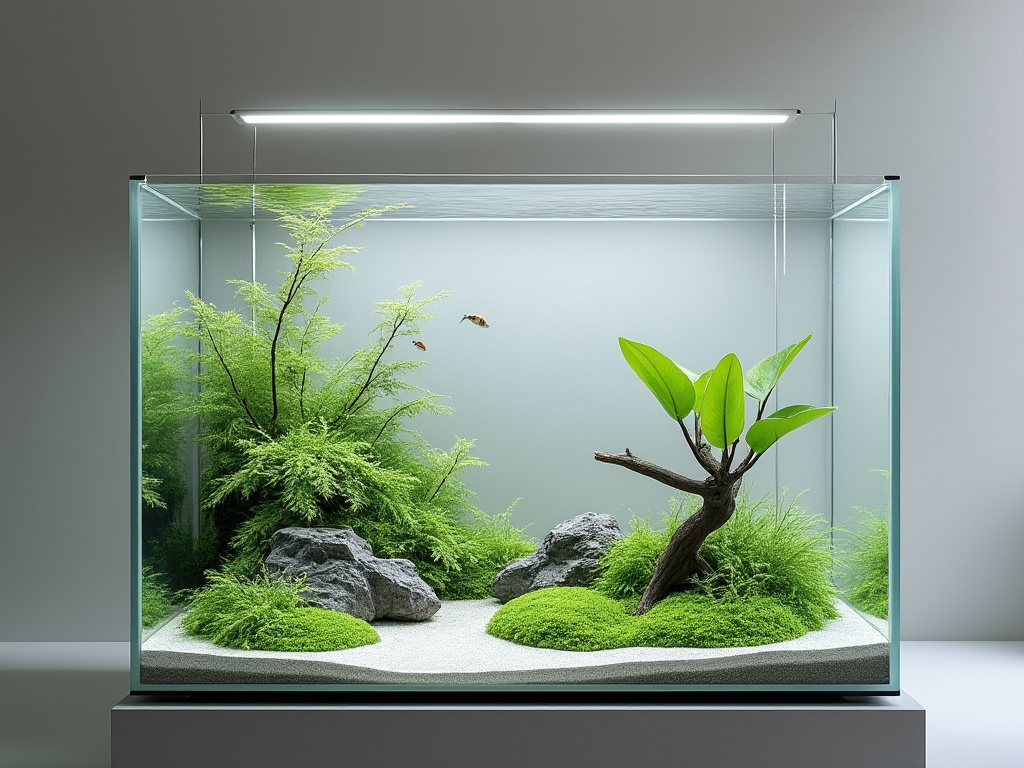Table of Contents
![]()
Introduction
In the world of aquascaping, minimalism has carved out a niche that resonates deeply with enthusiasts who value simplicity, elegance, and the art of less. Minimalism in aquarium design refers to the practice of using only essential elements to create an environment that is both functional and aesthetically pleasing. This approach contrasts with the more cluttered, busy setups common in traditional aquariums. Historically, minimalism has been influenced by broader art and design movements, bringing a philosophy of “less is more” into the underwater world.
Philosophy of Minimalist Aquascaping
Less is More
In minimalist aquascaping, the focus is on creating impact with minimal elements. Instead of filling the tank with numerous plants, rocks, and fish, a minimalist aquarium might feature just a few species of fish, one or two types of plants, and perhaps a single piece of driftwood or rock formation.
Balance and Harmony
The beauty of a minimalist setup lies in its balance. Every piece in the tank serves a purpose, contributing to a harmonious visual and biological environment. The arrangement promotes a sense of peace and order.
Zen Aesthetics
Drawing from Zen principles, minimalist aquariums aim to evoke tranquility. The simplicity of the design can mirror the Zen garden, where every element has a place and purpose, contributing to an overall serene atmosphere.
Key Elements of a Minimalist Aquarium
Substrate
Often, minimalist aquariums will forgo traditional substrates entirely or use a thin layer of sand. This not only maintains the clean lines and simplicity of the aesthetic but also simplifies maintenance.
Hardscape
- Rocks: Selection is key; choosing one or two types of rocks can define the tank’s character without clutter.
- Wood: A single piece of driftwood can serve as both a visual anchor and a functional element, providing shelter for fish.
Plant Life
- Low Plant Count: The choice might be limited to one or two plant species, such as Anubias or Java Fern, known for their simple, elegant forms.
- Plant Placement: Strategic placement ensures each plant enhances the visual flow, often placed to contrast with the hardscape.
Fish
- Species Selection: Fish like bettas, rasboras, or even small schools of neon tetras can complement the minimal design, chosen for both their visual appeal and their ability to thrive in sparse environments.
- Stocking Density: Keeping the number of fish low helps maintain the minimalist ethos, ensuring each fish is a focal point rather than part of a crowd.
Design Principles
Space Utilization
Emphasizing negative space is crucial. The empty areas are not voids but parts of the design, creating a sense of tranquility and directing focus to the few elements present.
Color Scheme
A minimalist palette might use monochromatic tones or limited colors to maintain visual coherence, focusing on texture and form rather than a riot of colors.
Lighting
Lighting should be soft and natural to enhance the simplicity without overpowering it, often using indirect light sources to highlight the tank’s features subtly.
Maintenance and Functionality
Ease of Maintenance
With fewer elements, cleaning and maintenance become simpler tasks. Water changes, pruning, and cleaning are less time-consuming and less frequent in a minimalist setup.
Biological Load
A lower biological load due to minimal plant and fish numbers aids in maintaining water quality, making the ecosystem easier to manage.
Equipment
Even the equipment is minimalist, often with one filter and one heater, possibly hidden or integrated into the design to maintain aesthetic purity.
Benefits of Minimalist Aquariums
Aesthetic Appeal
The art lies in its simplicity. A well-executed minimalist aquarium can be more visually striking than a tank filled with numerous elements.
Mental Health
The calm, serene environment of a minimalist tank can have a therapeutic effect, similar to that of a Zen garden, providing a space for relaxation and reflection.
Educational Value
With fewer distractions, observing fish behaviors, plant growth, and biological interactions becomes more straightforward and educational.
Challenges and Considerations
Over-Simplification
There’s a risk of the tank appearing barren if not designed thoughtfully. The challenge is to maintain interest with minimal elements.
Ecosystem Balance
Ensuring a healthy ecosystem with fewer biological components requires careful planning to avoid instability.
Personal Taste
Not everyone will appreciate minimalism, as it might not align with all personal tastes or the desire for a more vibrant, biodiverse setup.
Inspirational Examples
Case Studies
Highlighting real-world examples from aquarists who have mastered minimalist designs can inspire others. These might include tanks that use a single piece of wood or rock as the centerpiece, with just a few fish and plants.
Before and After
Showing transformations from traditional, cluttered aquariums to minimalist ones can illustrate the impact of this design philosophy.
Conclusion
Minimalist aquariums offer a unique blend of art and science, where the beauty is in the restraint. They challenge aquarists to think differently about space, form, and life. For those who appreciate the elegance of simplicity or are looking for a low-maintenance yet visually appealing setup, exploring the minimalist approach might just open up a new world of underwater beauty. Whether you’re an experienced aquarist or a beginner, the minimalist aquarium invites you to appreciate the profound in the simple.
Share This





Be the first to comment